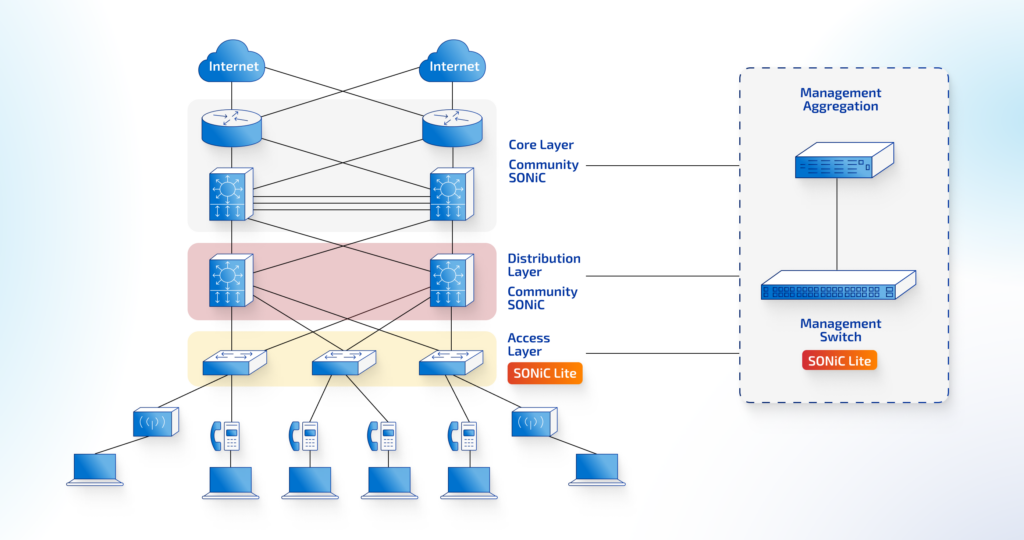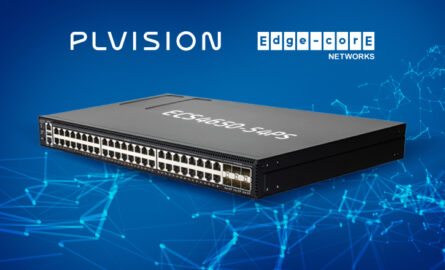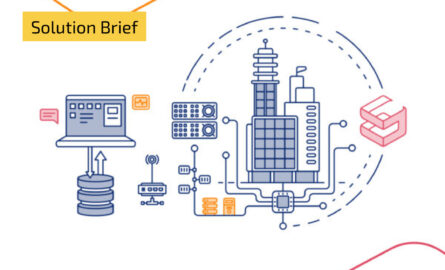Even the most experienced IT directors can feel overwhelmed by a network riddled with outdated switches and vendor-imposed limitations. At PLVision, we’ve been in the networking for over 17 years, and our evolution from a fragmented, proprietary infrastructure to a unified, vendor-neutral approach has been nothing short of an adventure. Now, we are sharing our experience of transitioning to open source with SONiC Lite – a solution that not only resolved our legacy issues but also unlocked new levels of flexibility and cost efficiency.
1. About the Company
PLVision is a networking software product development company with a proven track record of serving industry leaders, hyperscalers, and innovative startups. Since 2007, we have been leveraging our deep expertise in open networking technologies like SONiC, DASH, and DentOS to deliver comprehensive solutions – including our own ready-to-use products – that eliminate vendor lock-in, enhance security, and improve cost-efficiency.
2. Situation Summary: When Your Network Becomes a Maze
Despite our extensive expertise in open networking solutions, our own internal network, at the time, reflected the typical challenges of a growing business. Like many small and medium-sized companies, our infrastructure has evolved into a variety of interconnected systems. Over the years, we had accumulated a diverse mix of switches from multiple vendors and eras. This patchwork infrastructure, layered with different technologies, became increasingly complex and difficult to manage. Each switch had its own CLI, its own way of doing things. It was a constant juggling act, and our IT team was stretched thin.
Stick with expensive, proprietary solutions or brave the open-source alternative? We opted for the second – embracing disaggregation to achieve vendor neutrality, scalability, and improved cost efficiency.
The traditional proprietary approach had served its time, but the challenges were mounting:
- Outdated Equipment: Much of our hardware was nearing end-of-life, with dwindling support and an ever-present risk of failure.
- Vendor Lock-in: We faced limitations. Relying on a single-vendor solution became increasingly costly, while transitioning to a different vendor posed challenges. White-box disaggregation offered a promising alternative, though it initially seemed complex.
- Operational Inefficiencies: Each device required specialized knowledge, making troubleshooting and scaling a constant struggle.
We needed a change and considered two options: 1) a costly, vendor-locked refresh, or 2) embracing disaggregation with white box switches and open-source NOS. We chose the latter, though we knew it wouldn’t be a walk in the park. But the potential for scalability, cost optimization, and vendor neutrality was too enticing to ignore.
3. The SONiC Lite Solution
At PLVision, we don’t just develop products – we use them ourselves to solve our own issues. After all, who’s a tougher customer than your own internal team? If it worked for us, it would work for others.
SONiC Lite is an enterprise distribution of SONiC by PLVision for cost-effective management and access platforms in data center, edge, and campus deployments. It enables the construction of networks using less demanding and more affordable networking equipment while remaining hardware vendor neutral.
We chose SONiC Lite because it addressed our key needs:
- Vendor Neutrality & Cost-Effectiveness. Freedom to choose hardware based on price and performance, not brand loyalty. Optimized hardware costs meant serious savings.
- Simplified Management. Streamlined processes that reduced complexity and led to more efficient network troubleshooting.
- Robust Feature Set. SONiC Lite retains all the essential functionalities of Community SONiC – L2 switching, L3 routing, and security – while integrating additional critical features such as xSTP, OLS, PoE++, RADIUS, and more.
- Tailored for the Access Layer. Designed specifically for access switches, it ensures reliable connectivity for end devices like PCs, printers, and wireless access points.
- White Box Model Flexibility. A platform we could grow with, without ripping and replacing everything. SONiC Lite liberated us from the confines of traditional vendor ecosystems, making it a perfect match for enterprises with a “zoo” of existing switches.
Of course, transitioning to an open-source NOS required adjustments. Unlike proprietary systems with a one-size-fits-all roadmap, the flexibility of SONiC Lite meant there wasn’t a single, prescribed path to deployment. We were presented with multiple options – and the responsibility to choose the best one for our environment.
4. Implementation Process
Adopting SONiC Lite was both exciting and challenging. We started with an access layer – the foundation of our network – by deploying SONiC Lite on the switches connecting our PCs, printers, and Wi-Fi access points.

Let’s be honest, the implementation wasn’t always smooth, and we encountered some typical challenges of transitioning from proprietary solutions to an open-source network. Configuring SONiC Lite to ensure seamless integration with our existing infrastructure required careful planning and adjustments. The unfamiliar environment and SONiC Lite’s learning curve meant our team had to adapt to a new way of doing things.
Additionally, while SONiC Lite is vendor-neutral, ensuring hardware compatibility was crucial. We conducted checks and updates to guarantee that all network hardware could support SONiC Lite without issues.
We started with the most recent SONiC Lite release, featuring full KLISH CLI support, which provided a powerful command-line interface that streamlined configurations.
With detailed planning, comprehensive guides, and support from engineers, our initial struggles soon transformed into a smooth migration. Every configuration tweak and integration highlight were documented, allowing us to overcome obstacles with confidence. The benefits of our transition quickly began to outweigh the growing pains.
SONiC Lite Free Demo
Implement SONiC on cost-effective
platforms with SONiC Lite
5. Results
The results speak for themselves. Deploying SONiC Lite has improved our network management and operations. Here’s what we achieved:
- Increased Flexibility: The white-box model enabled seamless integration of hardware from multiple vendors while maintaining full functionality. Continuously expanding Hardware Compatibility List (HCL) ensures expanded flexibility and broader support.
- Management Efficiency: SONiC Lite’s centralized management and simplified configuration via KLISH CLI have streamlined operations, allowing our IT team to focus on strategic initiatives.
- Optimized Total Cost of Ownership (TCO): With SONiC Lite’s lightweight design, hardware neutrality, and enhanced performance, we achieved noticeable cost reductions.
- Enhanced Reliability: Regular updates, security patches, and performance enhancements keep our network resilient.
- Scalability: SONiC Lite’s ability to manage increasing network demands ensured stability as we expanded.
- Continuous Feature Development: Ongoing feature updates keep the network aligned with technological advancements.
- Unexpected Benefits: The deployment process revealed new opportunities for Open Wi-Fi integration and improved network visibility, exposing previously undetected bottlenecks.
The initial complexity and decision overload made us question our choices at times. But every challenge reinforced our conviction that the long-term benefits far outweighed the short-term hurdles.
6. Conclusions
SONiC Lite is more than just a network operating system – it’s a proven solution that empowers small and medium-sized businesses to optimize their infrastructure. By streamlining network operations, especially in environments with diverse switches and less demanding equipment, SONiC Lite delivers tangible benefits today while positioning your business for future modernization.
PLVision’s deployment of SONiC Lite showcases its transformative impact on modern enterprise networking. By addressing our internal challenges, we’ve demonstrated its feasibility and effectiveness – setting a strong precedent for other organizations looking to optimize their edge networks.
With a successful track record in SONiC-based networks, SONiC Lite enhances performance, simplifies management, and proves that open-source solutions can create robust, scalable, and cost-effective networking environments.
It’s not just a concept – it’s here, it works, and it’s ready to transform your network challenges into success stories. Feel free to explore our SONiC Lite resources and discover how it can transform your network:
- SONiC Lite Product Brief
- SONiC Lite Demo
- SONiC Lite Demo Setup Instructions
- Step-by-Step PNAC Configuration.
Start your journey with SONiC Lite today and improve your network infrastructure with confidence.
- How PLVision Transformed
Its Enterprise Network
with SONiC Lite - February 20, 2025


